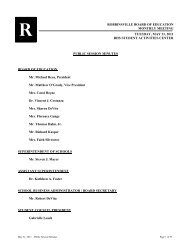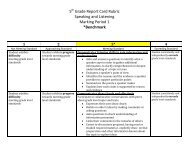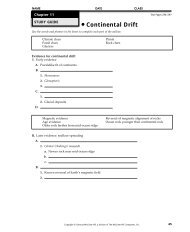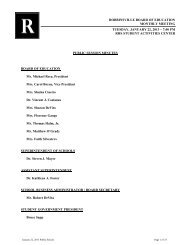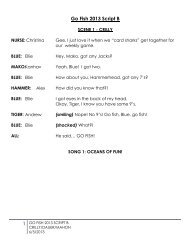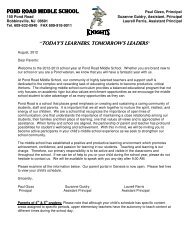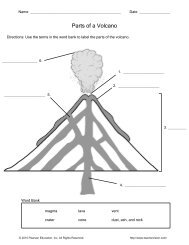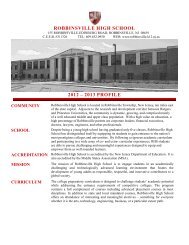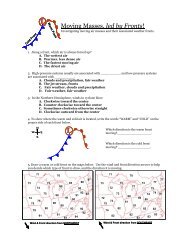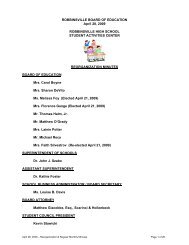Writing - Robbinsville Public School District
Writing - Robbinsville Public School District
Writing - Robbinsville Public School District
You also want an ePaper? Increase the reach of your titles
YUMPU automatically turns print PDFs into web optimized ePapers that Google loves.
Fourth Grade<br />
INDICATORS:<br />
• Writers develop a realistic fiction story based on everyday moments in their lives.<br />
• Writers develop characters with wants, realistic and consistent external and internal features, who face and<br />
overcome challenges.<br />
• Writers ground scenes with realistic setting and dialogue.<br />
• Writers develop secondary characters that interact with the main character.<br />
• Writers structure their story using a story mountain, developing a rising action, turning point, and resolution.<br />
• Writers rehearse and revise their writing throughout the writing process – especially before and while drafting –<br />
rather than wait until the end of the writing process.<br />
• Writers reread and revise their writing through various lenses.<br />
• Writers make reading-writing connections with mentor texts, using mentors to shape their own realistic fiction<br />
writing (idea generation, internal and external characteristics, setting, dialogue, the arc of the story, beginnings,<br />
and endings).<br />
• Writers use mentor texts to shape dialogue, make paragraphing decisions, and accurately use punctuation<br />
including quotation marks, commas, question marks, periods, exclamation points, and ellipses.<br />
Common State Standards for English Language Arts<br />
Reading Standards Literature:<br />
RL 4.3<br />
Reading Standards Foundational Skills<br />
RF 4.3, 4<br />
<strong>Writing</strong> Standards K-5<br />
W 4.3, 4, 5, 6, 8,10<br />
Speaking and Listening<br />
SL 4.1<br />
Language Standards<br />
L 4.1, 2, 3, 4, 6<br />
21 st Century Skills:<br />
Creativity and Innovation Critical thinking and Problem Solving<br />
Communication<br />
Collaboration<br />
<strong>Writing</strong> Process<br />
COLLECTING CHOOSING DEVELOPING DRAFTING REVISING EDITING<br />
PUBLISHING<br />
AND<br />
CELEBRATING<br />
POSSIBLE MENTOR TEXTS<br />
Mentor Texts:<br />
The Wall by Eve Bunting<br />
The Other Side by Jacqueline Woodson<br />
Oliver Button is a Sissy by Tomie DePaola<br />
“Seeing, Really Seeing” from Chicken Soup for the<br />
Children’s Soul<br />
The Three Billy Goats Gruff by Paul Galdone. (1981).<br />
Come On, Rain! by Karen Hesse. (1999)<br />
Pet Show! by Ezra Jack Keats. (2001).<br />
The Wednesday Surprise by Eve Bunting. (1989).<br />
“John and the Snake” in Childtimes: A Three<br />
Generation Memoir by Eloise Greenfield and Lessie<br />
Jones Little. (1993).<br />
A Chair for My Mother by Vera B. Williams. (1984).<br />
<br />
<br />
<br />
<br />
TEACHER RESOURCE TEXTS<br />
<strong>Writing</strong> Fiction: Big Dreams, Tall Ambitions Grades 3-5 by<br />
Calkins and M. Colleen Cruz, book four from Units of Study<br />
for Teaching <strong>Writing</strong>, Grades 3-5. (2006).<br />
Text Forms and Features: A Resource for Intentional<br />
Teaching by Margaret Mooney. (2001).<br />
Past Perfect, Present Tense: New and Collected Stories by<br />
Richard Peck. (2004).<br />
Teaching for Comprehending and Fluency: Thinking,<br />
Talking, and <strong>Writing</strong> About Reading, K-8 by Irene C. Fountas<br />
and Gay Su Pinnell. (2006).<br />
<strong>Robbinsville</strong> <strong>School</strong> <strong>District</strong> page 48



